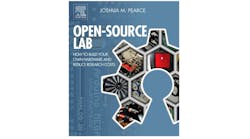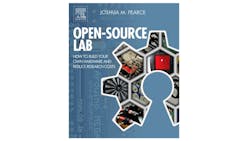Research projects can benefit from do it yourself (DIY) techniques to design and build open-source hardware.
"Open-Source Lab: How to Build Your Own Hardware and Reduce Research Costs" was written by Joshua M. Pearce, a member of the faculty of Michigan Technological University, Houghton, MI. The book is intended as an introductory guide on how to take advantage of the benefits of open-source hardware for science-related projects.
Briefly, the chapters are:
· 1. Covers the basics of open source, a brief overview of the history and etiquette of opensource communities.
· 2. Explains the theoretical argument for why this method of technological development is superior to the standard models. It describes why nice guys finish first both in research and at the industrial scale.
· 3. Covers the nitty-gritty of open-source licensing.
· Chapters 4 and 5 describe the most useful tools for fabricating open-source scientific equipment.
· 6. “The heart of the book,” describes digital designs for open-source scientific hardware in physics, engineering, biology, environmental science and chemistry.
· 7. Peeks at the future and possible ramifications of large-scale adoption of open-source hardware and software for science.
The author notes that the process of development and licensing for free and open-source software, discussed in Chapters 2 and 3, has been a success and led to its application for hardware. This can radically reduce the cost of experimental research in the sciences and has the potential to reduce research costs and make a laboratory more productive. In particular, this book focuses on the combination of open-source microcontrollers covered in Chapter 4 and open-source 3-D printing reviewed in Chapter 5. These two tools running on free open-source software enable the development of powerful research tools at unprecedented low costs.
Free and open-source software (F/OSS, FOSS) or free/libre/open-source software (FLOSS) is a software that is both a free software and an open source.FOSS is a computer software that is available in source code (open-source) form and that can be used, studied, copied, modified, and redistributed without restriction, or with restrictions that only ensure that further recipients have the same rights under which it was obtained (free or libre) in modified or unmodified form either without restriction or with restrictions that only ensure that further recipients have the same rights under which it was obtained and that manufacturers of consumer products incorporating free software provide the software as source code. The word “free” in the term refers to freedom (liberty) to use and not monetary cost. Although FOSS is often available without charge, it is not bound to such a restriction.
Chapter 4 says that 3-D printing has been used for rapid prototyping since the late 1980s. The more recent technical explosion in innovation for 3-D printing has been substantial, fueling rapid growth in commercial rapid prototyping for a huge swath of industries. open-source 3-D printing is really what has cut the cost of rapid prototyping so that it is now accessible to basically everyone. Perhaps the first group to benefit the most financially is practicing experimental scientists. These self-replicating rapid prototypers, or RepRaps were developed by Dr Adrian Bowyer, a professor in mechanical engineering at the University of Bath in 2005. Bowyer has a particularly clear view of what having a general-purpose self-replicating manufacturing machine means for humanity and how the project was able to literally evolve under the open-source paradigm.
Chapter 6 provides examples of scientific equipment produced using the open-source hardware (OSH) paradigm. This section provides the basic background in the use of three primary toolsets for OSH equipment. First, the use of parametric open-source designs using an open-source computer-aided design (CAD) package is described to customize scientific hardware for any application. This tool will then be used as the example for many scientific and engineering disciplines throughout the chapter whenever possible. Second, it provides details on how to use the open-source 3-D printers discussed in Chapter 5 to fabricate both the primary components of scientific tools and how to construct complex, multicomponent engineering and scientific devices. Finally, open-source electronic prototyping platforms, such as were discussed in Chapter 4, will be demonstrated to control complex scientific devices saving your lab time, money, and improving your research productivity.
Chapter 7 is an Introduction to the Future. The author notes: “We are all somewhat accustomed now to the rapid advancement in technology and the younger (or at least younger at heart) we are, the more likely it is that we are at home with embracing the accelerated changes of bringing ever-greater technologies into our lives. In experimental science and engineering, the tools to participate in the advancement of this technology have skewed the costs so high that they are beyond the grasp of all but the most well-funded research groups.”
The book can be purchased here.

